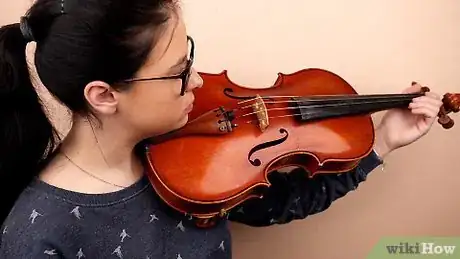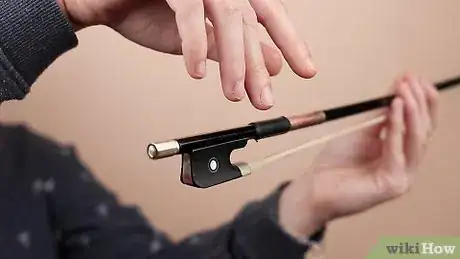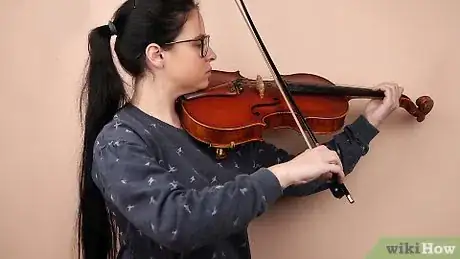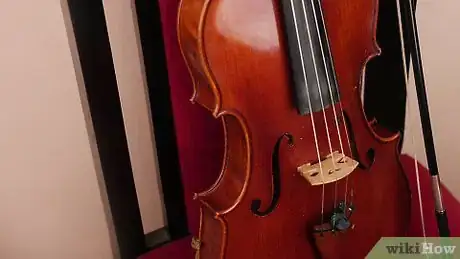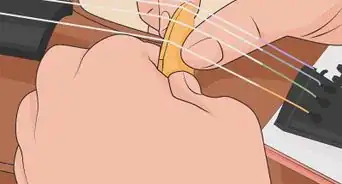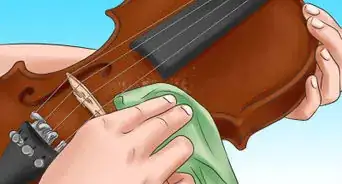This article was co-authored by wikiHow Staff. Our trained team of editors and researchers validate articles for accuracy and comprehensiveness. wikiHow's Content Management Team carefully monitors the work from our editorial staff to ensure that each article is backed by trusted research and meets our high quality standards.
The wikiHow Video Team also followed the article's instructions and verified that they work.
This article has been viewed 17,347 times.
Learn more...
Learning the viola is a multi-step process. Therefore, you want to start out with good habits that you can develop as you play the instrument. By doing this, you should be able to practice and play without discomfort. Positioning your viola correctly, holding your bow carefully, and keeping good posture will allow you to play the viola comfortably.
Steps
Positioning Your Viola
-
1Hold the viola under the peg box. This is the place near the top where the strings connect to the pegs.
-
2Position your viola. It should be between your shoulder and chin. Your viola should touch your left collarbone.Advertisement
-
3Keep your head up.[1] The end pin should be pointing towards the center of your neck. Ensure that the viola does not fall too far forward or too far back.
- Practice moving your viola next to your collarbone. Gently push the viola into the space between your shoulder and head. Repeat these movements.
-
4Rest your chin on the chin rest. The chin rest is a round shaped pad that will be found either on the right side or the middle of your viola. Lean the left side of your jaw onto it. Ensure that the viola is comfortably between your chin and left shoulder/collar bone.
-
5Keep the instrument at an angle. You should keep your viola at 45 degree angle. Do this so that the instrument’s strings are accessible at all times. For a good measure, figure out if the slope of your viola is parallel with the ground. If the instrument is too low, you will have to move your hands further to reach it.
-
6Do not grip the instrument. Your body should be supporting it. The neck of your viola should rest in the gap between your left thumb and index finger. This position will allow your fingers to move easily and hover over the strings comfortably.
- The string closest to your fingers should be your A string (highest pitched string).
- The one closest to your thumb should be the C string (lowest pitched string).
Holding the Bow
-
1Hold the bow with your right hand. Make a c-shape with the middle and ring fingers of your right hand.
-
2Lay your fingers on the bow. Gently rest your thumb on the inner part of the bow frog, allow your other fingers to fall on the bow’s other edge. [2] Loosen up your fingers but keep them together. Your fingers should wrap around the bow in a smooth, yet secure hold.
-
3Curve your pinky. Your pinky should rest on the head of the stick.
-
4Twist your hand left. Curve your hand around the bow, so you can move it swiftly.[3]
Keeping Your Posture
-
1Stand correctly. Maintain balance by standing with your feet shoulder-width apart. Make sure your stance is firm, straight, and upright. Try swaying forwards and backwards to keep your weight centered.
-
2Sit appropriately. Keep your back straight. Your sitting viola hold should be similar to your standing hold. Relax your knees. Be firm, but not stiff.
-
3Use a chair. If it will make you more comfortable, don’t be afraid to use a chair with a firm surface. Stay close to the chair’s edge.Do not sit on a couch, you may end up slumping back in it.[4]
-
4Move your arms away from your body. Your arms should not stay too close to the rest of your body. If they stay too close, they will hinder your amount of movement.
Community Q&A
-
QuestionHow do I put on a shoulder rest?
 Community AnswerThe larger side of the shoulder rest goes on the bottom side of the viola, under the chin rest. The thinner side also goes under the viola. You should attach it to the lip of the underside. Feel free to adjust it as is comfortable. To make it easier for yourself, hold the viola firmly under your arm, then attach it.
Community AnswerThe larger side of the shoulder rest goes on the bottom side of the viola, under the chin rest. The thinner side also goes under the viola. You should attach it to the lip of the underside. Feel free to adjust it as is comfortable. To make it easier for yourself, hold the viola firmly under your arm, then attach it. -
QuestionThe viola won't stay on my clavicle. What should I do?
 Community AnswerYou should try holding it on your clavicle, towards your shoulder and away from your neck.
Community AnswerYou should try holding it on your clavicle, towards your shoulder and away from your neck.
References
About This Article
To properly hold a viola, place your left hand near the peg box, or the place where the strings connect to the pegs. Rest the viola at a 45° angle between your shoulder and chin so it’s touching your left collarbone. Keeping your head up, lay your chin on the chin rest at the end of the viola. The weight of your body should support the viola, so do not grip it tightly. To learn how to hold the bow, read on!


